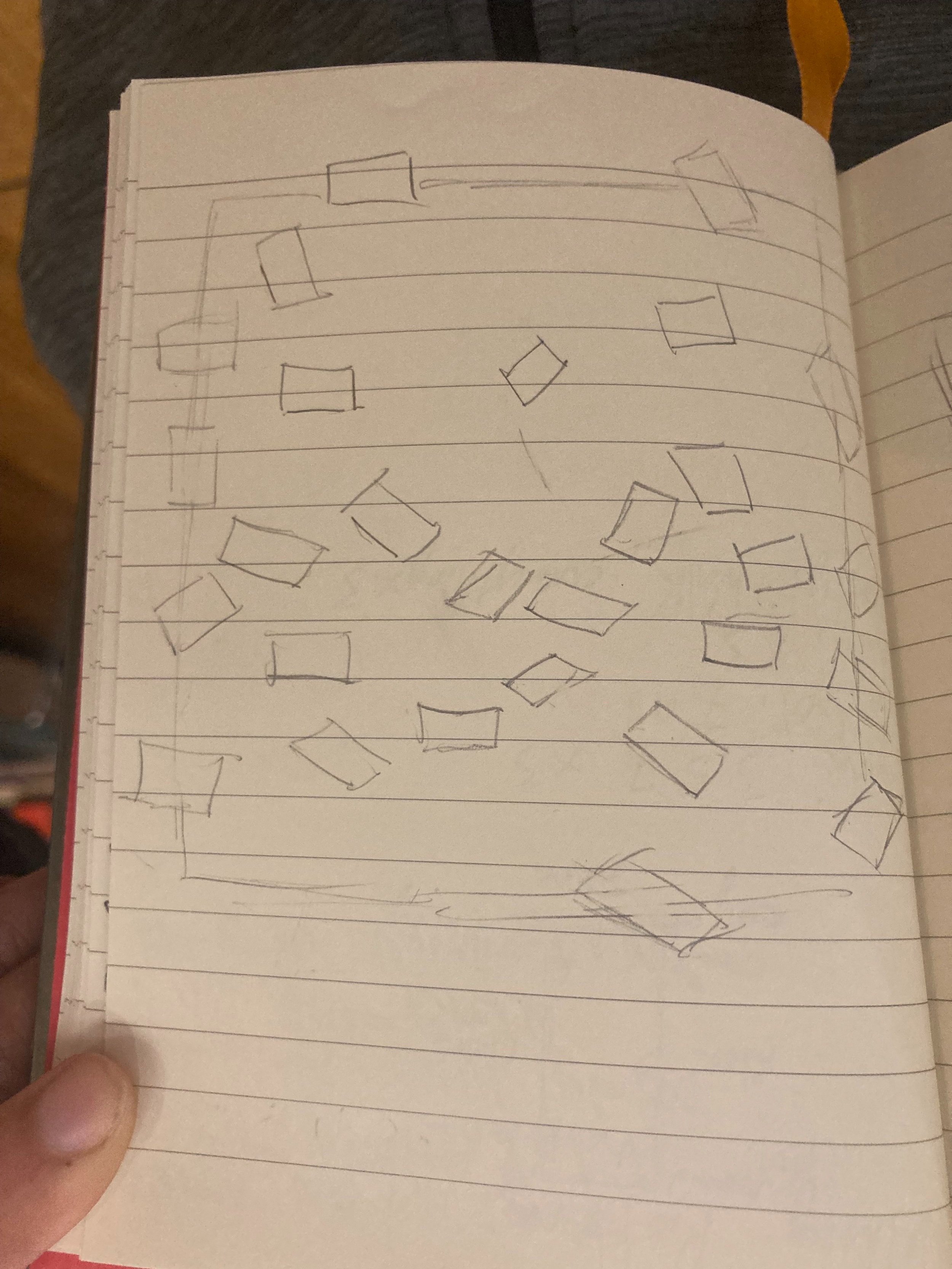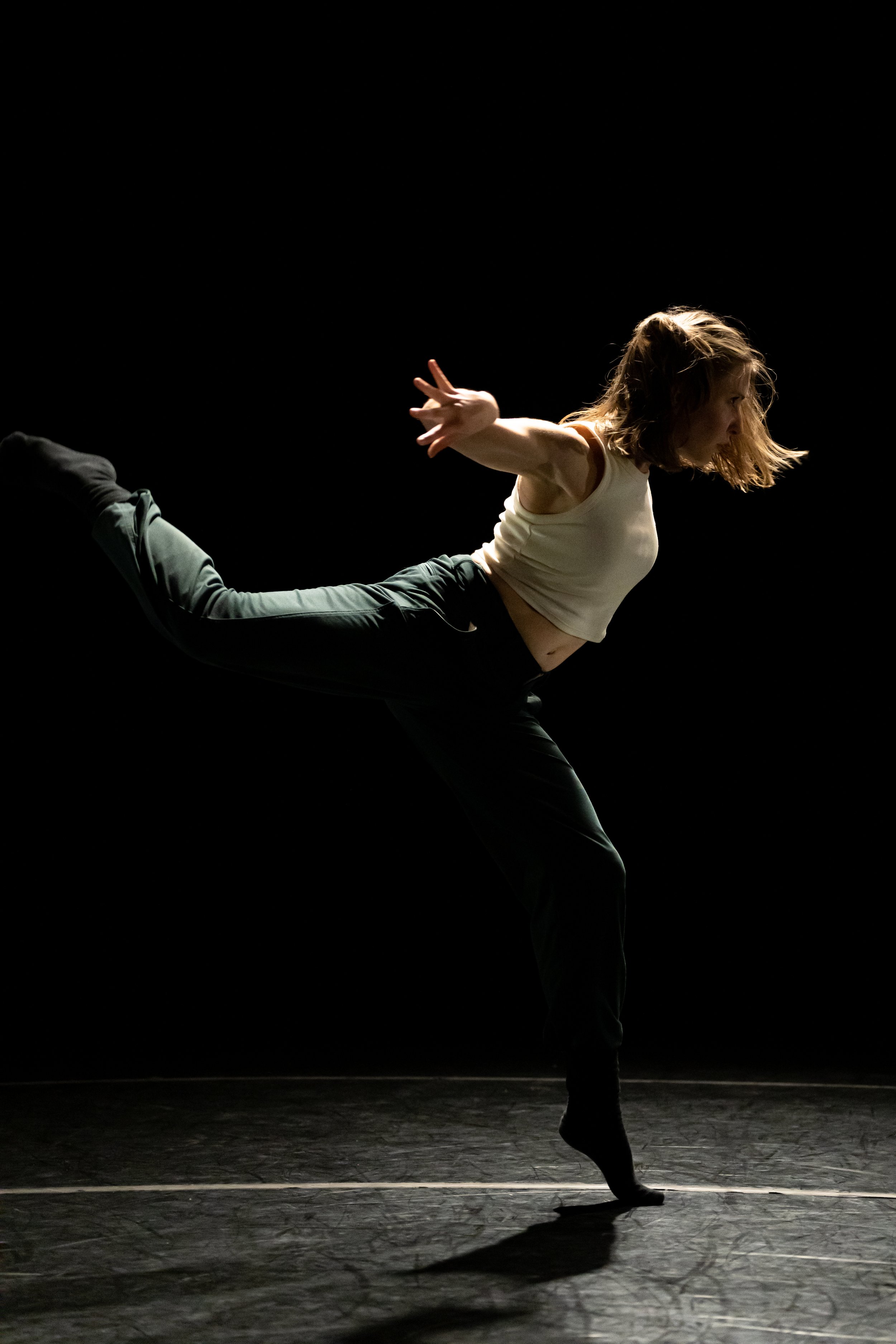Philip and Marie
Here, we are rehearsing one of BEGIN AGAIN’s base phrases at Gibney Dance on May 12, 2023
(The following is a condensed version of my conversation with Philip.)
Marie: How did you and Bennyroyce come together?
Philip: I first met Benny in 2013. I was a student, I think I was in eighth grade, and he performed and then taught a masterclass at CHOP SHOP here in Seattle. So, I saw his work and got to learn from him and I was captivated. Then, we reconnected in New York City many years later in 2019, right after I’d graduated from college. I auditioned for a project, and we have worked together pretty consistently since then.
M: Have you participated in choreographic processes that included non-moving collaborators in the past?
P: Recently, dancing with Bill T. Jones/Arnie Zane Company, there’s a lot of video design that goes into one of the productions we’ve been doing, and it’s very integral to the piece. It was really interesting to not see the video basically until we got to the stage. It’s such a crucial element. And, actually, similarly to what we are doing in this process, it’s included video of the dancers.
M: Inside Begin Again, are perceiving yourself as yourself, or are you building a separate character?
P: I am definitely “Phil.” I would say I’m focusing on an arc of myself that is sort of from the beginning of this process last summer to now, and a lot of my personal lived experience at that time and since then. Also, I am definitely considering “Phil,” as my pandemic experience trajectory is more informing. I am actually very consciously with this process trying to bring a lot of my own experiences, feelings, emotions into the movement and the room. I think Benny has created an environment that really allows that to happen organically. Also, just because of the nature of the work. I don’t think I’ve ever done a professional piece or process where I was very confidently like, “I’m doing me and I’m doing me on a very intimate level.” I mean, it won’t necessarily show explicitly in the movement or the performance, but I am really letting emotion and my lived experience inform how I approach everything.
M: Do you think the difference will show to those who already know you as a performer?
P: Yes, it will show. It’s a big shift for me. It’s exciting, because I think I wouldn’t have made this shift until I was in a process that allowed it organically. Knowing Benny, coupled with the subject matter of the piece, it was a no-brainer to be like, “Yeah, I’m being Phil,” which is cool.
M: How would you describe your level of agency within the total collaboration?
P: I can really distinctly remember the first process I ever did with Benny. It was a piece called IN PURSUIT, and it was a restaging of that piece. So, I was not in the original cast who were there when the piece was created. I was coming into the room and learning it, but I remember being really surprised that I felt really encouraged to take agency in the process of restaging. Since that was my first working experience with Benny, that’s always stayed. I’ve always felt like I could make decisions and take risks and that he would never discourage it. I feel very comfortable with that. Definitely in this process, I’m still operating like that. This is the first time with Benny where I’m an Artistic Associate, so I feel even more supported, like he’s calling agency out of me. I feel like my contribution is really important and necessary.
M: Is the trauma and healing work that is happening inside the concepts informing Begin Again’s creation process personal to you?
P: I feel like I’m really trying to let emotion affect my quality, texture. Even today in rehearsal, we were working on base phrase material that’s existed for almost twelve months now. But, I stopped before we started and thought about an event that I’m using to inform myself in BEGIN AGAIN. I let it spark emotion. I was like, “I’m going to let this moment be in my mind and my body and let it drive some change in how I’m going to do this movement that I’ve been doing.” There are definitely light and dark moments in BEGIN AGAIN. I’ve noticed that it’s much easier for me to find the dark moments and connect to those. I’m going to be curious how I’m going to, just because we focus so much on the pandemic narrative in the seed of this process, so I’m figuring out where the light moments are and how they connect.
M: What are your thoughts on the moments in Begin Again referencing the political realities around us?
P: I think that I’ve been thinking about how we find (in BEGIN AGAIN) the image of protest and then it dissolves. That’s really how protest has existed in American culture in recent times. We have these big, collective moments of action and protest and emotion that cross boundaries of gender and race and identity, and it’s really intense, and gets saturated really quickly. But then, it fizzles away, and that’s happened in many different cycles about many different issue in my adult memory. I am thinking about how, in the piece, that’s a little bit what I see: how we arrive there organically, and it falls away, and what does that mean that it falls away? Will it come back? Will the protests begin again?
M: Are you finding in Begin Again opportunities for self-reinvention? Or, has there been any new beginning for you performatively?
P: I’m thinking about how, in the midst of when we started this process last summer, was having almost a second career jumpstart in dance. Really, from the time the pandemic began, and then, right in summer of 2021, almost two years ago now, when I thought I was going to be, professionally, getting back in the saddle, full steam ahead dancing, I had a serious medical crisis that then pushed me back another six months in being able to be dancing a lot. And then, it took a long time to get back again. Finally, we get to the summer of 2022, and I was finally having a bunch of work happen, including coming to Seattle to do research and development for this piece. BEGIN AGAIN is connected, to me, to that big career “begin again”. I feel like I’ve started my professional dance career all over again, in a positive way. Coming back to Seattle now, to finish this incarnation of the piece, is a very sweet part of that beginning again. It’s a very fruitful moment; it feels good.
- Marie








